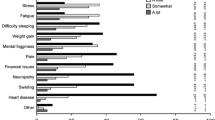Abstract
Background
Massage has shown benefit for symptomatic relief in cancer patients and their caregivers. We explored the effects of a single massage session on self-reported symptoms in an outpatient clinic at a comprehensive cancer center.
Methods
Patients and caregivers receiving oncology massage treatments (30 or 60-min duration) at our Integrative Medicine Center outpatient clinic from September 2012 to January 2015 completed the Edmonton Symptom Assessment Scale (ESAS; 0–10 scale, 10 most severe) pre and post massage. ESAS individual items and subscales of physical distress (PHS), psychological distress (PSS), and global distress (GDS) were analyzed. We used paired t tests with a p value correction (i.e., p < .001) to examine symptoms pre/post massage.
Results
Initial massage visits for 343 patients and 87 caregivers were analyzed. The highest symptom burdens (means) at baseline for patients were sleep 4.22, fatigue 3.57, and pain 2.94; for caregivers, sleep 3.77, well-being 3.01, and pain 2.59. Although patients reported significantly greater global distress and physical symptoms (p < .0001) compared to caregivers at baseline, groups did not differ in regard to psychological symptom burden (p = .66) and individual symptom scores (e.g., pain, sleep, spiritual pain). Massage therapy was associated with statistically (p < .0001) and clinically significant improvements in symptoms of pain, fatigue, anxiety, well-being, and sleep and ESAS subscales for both patients and caregivers. Greater massage duration (30 vs 60 min) did not lead to greater symptom reduction.
Conclusions
Patients and caregivers reported a moderately high symptom burden. A single massage treatment resulted in acute relief of self-reported symptoms in both groups. Further study is warranted regarding optimal massage dose and frequency.
Similar content being viewed by others
References
Kim JEE et al (2009) A review of the prevalence and impact of multiple symptoms in oncology patients. JPSM 37(4):715–736
Reeve BB, Mitchell SA, Dueck AC, et al. (2014) Recommended patient-reported core set of symptoms to measure in adult cancer treatment trials. J Natl Cancer Inest 106(7)
Deshields TL, Potter P, Olsen S et al (2014) The persistence of symptom burden: symptom experience and quality of life of cancer patients across one year. Support Care Cancer 22(4):1089–1096. doi:10.1007/s00520-013-2049-3
Cohen EE, LaMonte SJ, Erb NL et al (2016) American Cancer Society head and neck cancer survivorship care guideline. CA Cancer J Clin 66(3):203–239. doi:10.3322/caac.21343
Stan D, Loprinzi CL, Ruddy KJ (2013) Breast cancer survivorship issues. Hematol Oncol Clin North Am 27(4):805–827, ix. doi:10.1016/j.hoc.2013.05.005
Girgis A, Lambert S, Johnson C et al (2013) Physical, psychosocial, and economic burden of caring for people with cancer: a review. JOP 9(4):197–202
Schulz R, Beach SR (1999) Caregiving as a risk factor for mortality: the caregiver health effects study. JAMA 282(23):2215–2219
Stenberg U, Ruland C, Miaskowski C (2010) Review of the literature on the effects of caring for a patient with cancer. Psycho-Oncology 19:1013–1025
Collinge W, MacDonald G, Walton T (2012) Massage in supportive cancer care. Semin Oncol Nurs 28(1):45–54
Cassileth BR, Vickers AJ (2004) Massage therapy for symptom control: outcome study at a major cancer center. JPSM 28(3):244–249
Kutner JS, Smith MC, Corbin L et al (2008) Massage therapy vs. simple touch to improve pain and mood in patients with advanced cancer: a randomized trial. Ann Intern Med 149(6):369–379
Toth M, Marcanatonio E, Davis RB et al (2013) Massage therapy for patients with metastatic cancer: a pilot randomized trial. J Altern Complement Med 19(7):650–656
Wilkinson S et al (2007) Effectiveness of aromatherapy massage in the management of anxiety and depression in patients with cancer: a multicenter randomized controlled trial. J Clin Oncol 25:532–539
Mackereth P, Campbell G, Maycock P et al (2008) Chair massage for patients and carers: a pilot service in an outpatient setting of a cancer care hospital. Complement Ther Clin Pract 14(2):136–142
Horrigan B, Lewis S, Abrams DI et al (2012) Integrative medicine in America—how integrative medicine is being practiced in clinical centers across the United States. Glob Adv Health Med 1(3):18–94
Bruera E et al (1991) The Edmonton Symptom Assessment System (ESAS): a simple method for the assessment of palliative care patients. J Palliat Care 7:6
Hui D, Shamieh O, Eduardo Palva C et al (2015) Minimal clinically important differences in the Edmonton Symptom Assessment Scale in cancer patients: a prospective, multicenter study. Cancer 121(17):3027–3035
Hui D et al (2016) Minimally clinically important difference in physical, emotional, and total symptom distress scores of the Edmonton Symptom Assessment System. J Pain Symptom Manag 1(2):262–269
Acknowledgements
The contribution of our oncology massage therapists: Sat-Siri Sumler and Curtiss Beinhorn, for delivery of the massage intervention. This work was supported by a grant from The University of Texas MD Anderson Cancer Center Duncan Family Institute for Cancer Prevention and Risk Assessment, and partial support for Lorenzo Cohen was provided by the Richard E. Haynes Distinguished Professorship in Clinical Cancer Prevention.
Author information
Authors and Affiliations
Corresponding author
Ethics declarations
Conflict of interest
The authors declare that they have no conflict of interest.
Rights and permissions
About this article
Cite this article
Lopez, G., Liu, W., Milbury, K. et al. The effects of oncology massage on symptom self-report for cancer patients and their caregivers. Support Care Cancer 25, 3645–3650 (2017). https://doi.org/10.1007/s00520-017-3784-7
Received:
Accepted:
Published:
Issue Date:
DOI: https://doi.org/10.1007/s00520-017-3784-7




